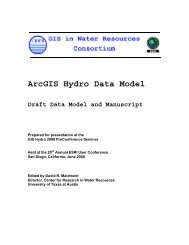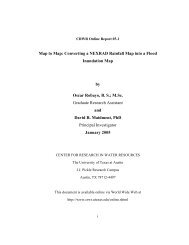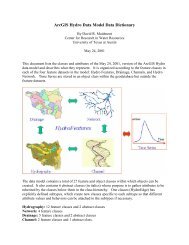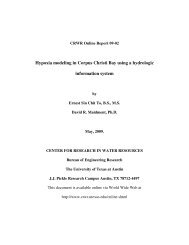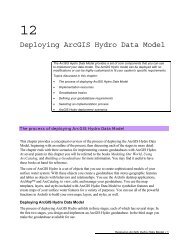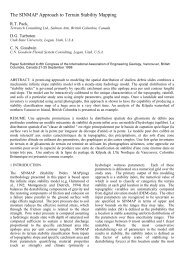View the Whole Report - Center for Research in Water Resources ...
View the Whole Report - Center for Research in Water Resources ...
View the Whole Report - Center for Research in Water Resources ...
You also want an ePaper? Increase the reach of your titles
YUMPU automatically turns print PDFs into web optimized ePapers that Google loves.
Two tests were run <strong>for</strong> each of three fabric samples; i.e., with and without<br />
application of a vacuum to <strong>the</strong> fabric specimens. Constant heads varied from 0.05-0.6 m.<br />
5.2.2 Results of Permeameter Tests<br />
The observed flow rates and a calculated permittivities at each head <strong>for</strong> <strong>the</strong> three<br />
fabric samples are presented <strong>in</strong> Appendix E. The permittivities (Ψ) observed <strong>in</strong> <strong>the</strong> tests<br />
at heads of 0.05 m were <strong>the</strong> same order of magnitude but slightly greater than <strong>the</strong><br />
permittivities reported by <strong>the</strong> manufacturers (see Table 5.7). This observation may be<br />
due to systematic differences between <strong>the</strong> permeameter test and ASTM D 4491.<br />
Table 5.7 Comparison of Ψ <strong>for</strong> 3 Fabrics Us<strong>in</strong>g ASTM D 4491 and a Permeameter<br />
(h = 0.05 m)<br />
Fabrics (not vacuumed) ASTM D 4491 Ψ, sec -1 Permeameter Ψ, sec -1<br />
Mirafi non-woven 1.5 2.1<br />
Amoco woven 0.2 0.36<br />
Belton woven 0.4 0.67<br />
Elim<strong>in</strong>at<strong>in</strong>g entrapped air appeared to have no consistent effect on flow rates<br />
through <strong>the</strong> fabrics. The flow rates <strong>for</strong> <strong>the</strong> non-woven Mirafi and <strong>the</strong> woven Belton were<br />
greater without elim<strong>in</strong>at<strong>in</strong>g entrapped air. The lower fabric permittivities observed <strong>in</strong> <strong>the</strong><br />
flume do not appear to be caused by air trapped <strong>in</strong> <strong>the</strong> fabric.<br />
A typical plot of flow rate versus head is presented <strong>in</strong> Figure 5.9. These data<br />
demonstrate a nonl<strong>in</strong>ear relationship between flow and head. The best-fit equations<br />
relat<strong>in</strong>g flow to head show that <strong>the</strong> flow is a power function of <strong>the</strong> head with exponents<br />
rang<strong>in</strong>g from 0.46 to 0.71.<br />
The ASTM method assumes that flow is lam<strong>in</strong>ar (i.e. viscous effects dom<strong>in</strong>ate);<br />
<strong>the</strong>re<strong>for</strong>e, <strong>the</strong> flow rate should be a l<strong>in</strong>ear function of <strong>the</strong> head (exponent equal to 1). If<br />
<strong>in</strong>ertial <strong>for</strong>ces dom<strong>in</strong>ate (turbulent flow), <strong>the</strong> flow rate should be a function of <strong>the</strong> square<br />
50




